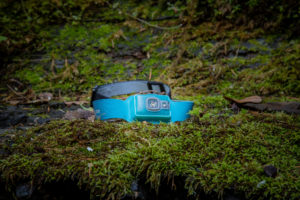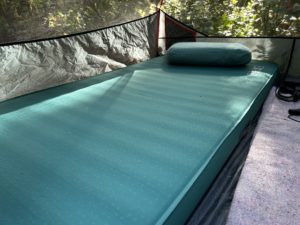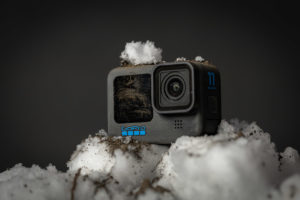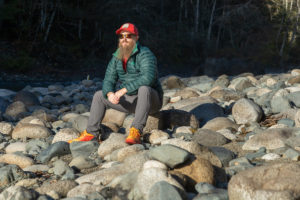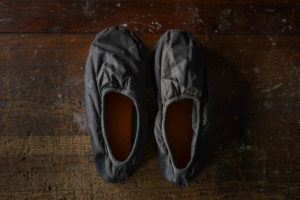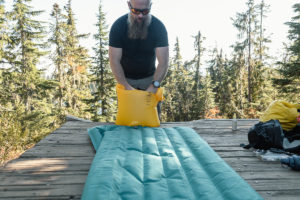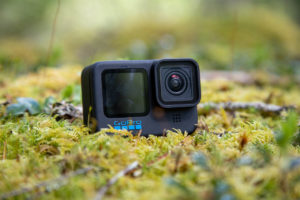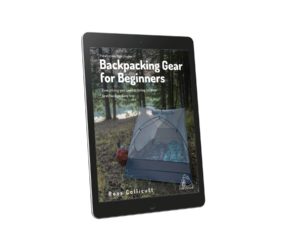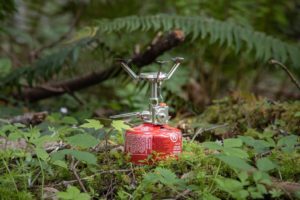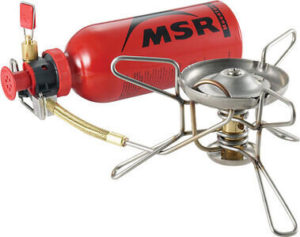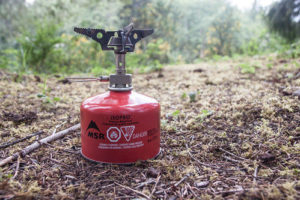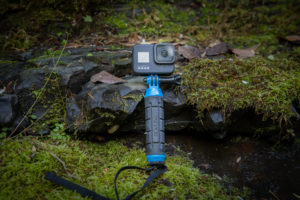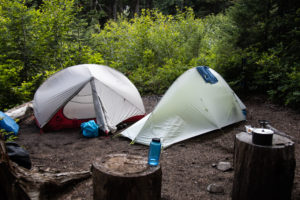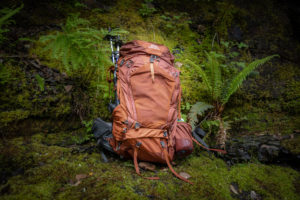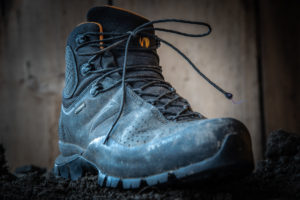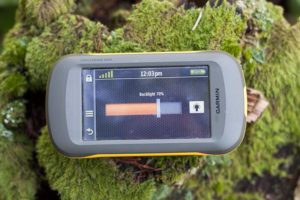When the lights go out in the backcountry, it’s dark. Like really dark. If you want to do anything safely after dark, or get that dawn patrol in before work, you’ll need a some sort of light,
Headlamps are easy to use, can be inexpensive and keep your hands free. Any light will work though. Some small flashlights come with straps to hold them in your hands or on your head.
Let’s dig into everything you need to know to buy a good headlamp for your adventures.
On this page:
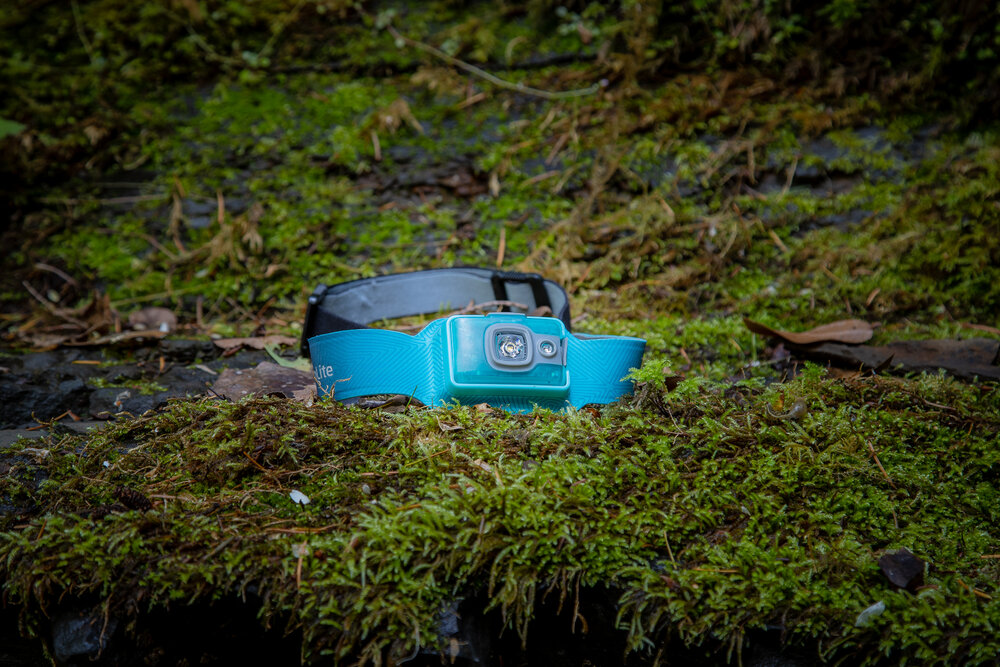
Headlamp Buying Guide
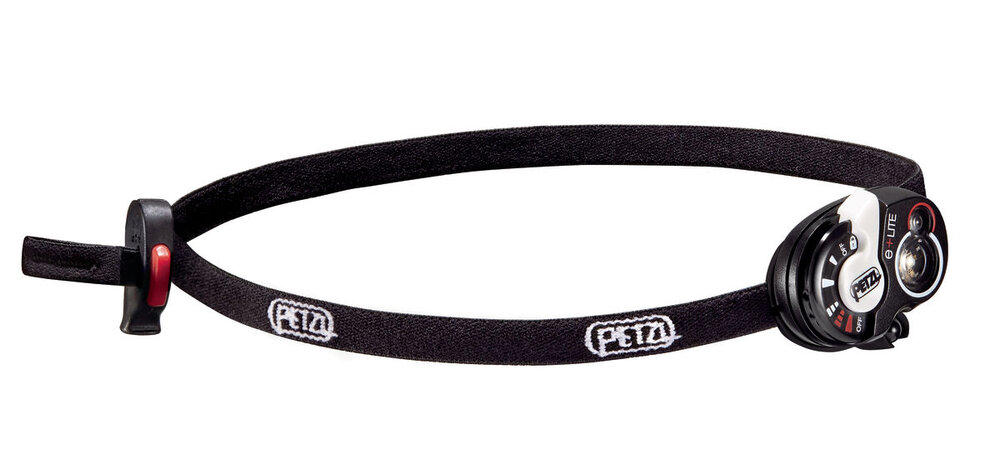
The Petzl e+Lite emergency headlamp
Lumens
Headlamp brightness is measured in lumens.
30 lumens works well for emergency use but for hiking or doing much at night you’ll want more. The e+Lite from Petzl is a very small 26 gram headlamp that puts out 30 lumens. It throws light about 7 metres. It’s a good size to have tucked away for emergencies.
For general purpose lighting and hiking at night, we recommend at least 300 lumens. They are packed into such a small package these days. The BioLite Headlamp 330 (330 lumens) and Petzl Actik Core (450 lumens) are both good picks for general purpose lighting.
450 lumen Actik Core shines out to 90 meters on maximum power. Standard and low will go to 45 and 8 metres.
Fit
Black Diamond Icon 700 Headlamp very bright and on the large end of headlamps.
Fit is important with headlamps. You may have it on your head for hours at a time.
Small, lightweight headlamps are usually soft and comfortable. They don’t have much weight to hang off your head.
When they get to a larger size like the Icon 700 from Black Diamond, they will be heavier with additional straps and battery packs.
Test out different headlamps if you can to see how they feel. All headlamp straps are adjustable.
We recommend looking for headlamp that’s as light as possible for how bright you need.
Battery life
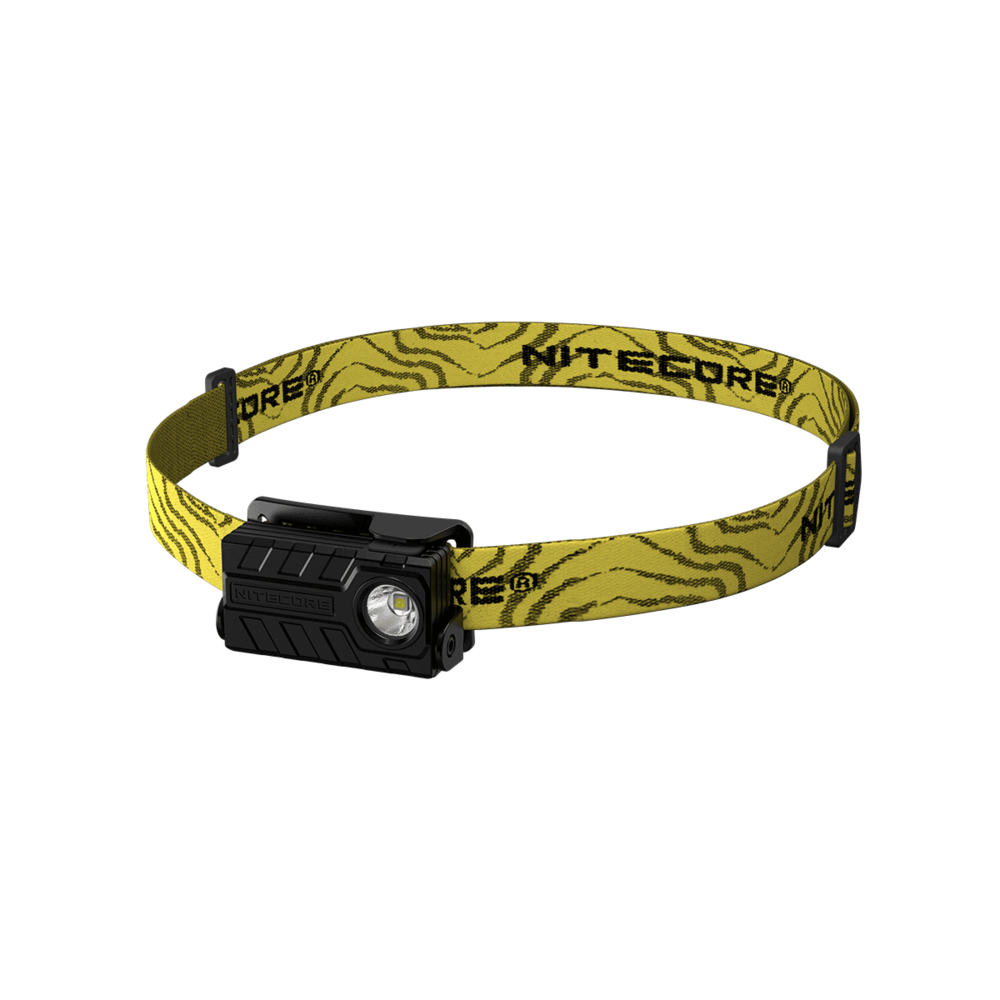
The bigger the battery the longer the battery. A bigger battery also means more weight. A Black Diamond Icon 700 with it’s large battery pack gets between 190 hours and 7 hours depending on the brightness you set it at. It needs a large battery pack to power than 700 lumens on max. It’s also going to weigh 236 grams (8.3 oz).
The Nitecore Nu20 headlamp on the other end is only 31 grams (1.09 oz). It packs 360 lumens into the small package so it’s not as bright as the larger headlamps but it’s much lighter. The battery lasts for 100 hours at a very dim brightness.
Most headlamps get between 50 and 150 hours at a decent brightness you can use for hiking. The low power setting is usually enough for tasks around camp when you don’t need to see very far and don’t want to blind your hiking buddies.
When checking battery life, make sure you know how bright the time corresponds to. The Nitecore NU20’s 100 hour battery life is based on it’s ultra-low 1 lumen low setting. The Icon’s battery life of 7 hours looks bad if you base it on the max power setting of 700 lumens. That could light up the whole campsite and you likely won’t use it for long.
If you can compare headlamps based on one of the medium settings, around 100 lumens, it will be a more fair comparison.
Battery style
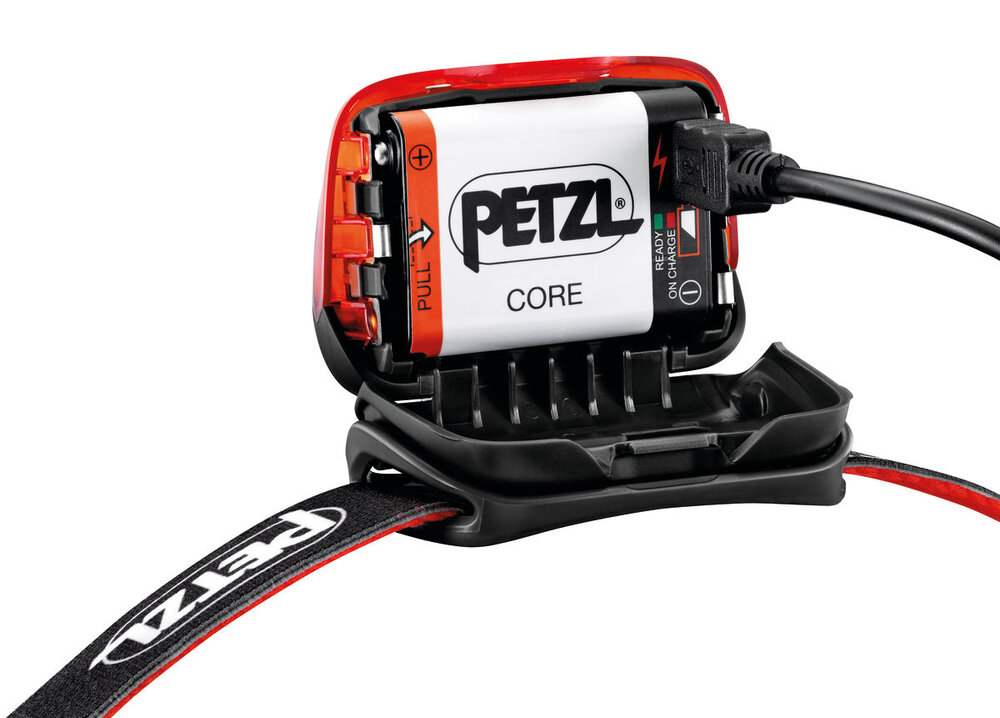
Petzl Actik Core USB rechargeable battery pack
Most headlamps run off AAA, AA or Lithium-ion rechargable packs. AAA and AA are easy to find at any store but are hard to recharge in the field. For USB rechargeable headlamps just take a battery pack and recharge it during the day or as it runs low on juice. Rechargeable units send fewer dead batteries to the landfill.
Petzl has taken a unique approach with some of their Core line of headlamps. The Actik Core comes with a rechargeable battery pack. You can easily get another battery pack to have a backup. It just charges through a micro USB port on the battery pack. The battery pack is conveniently exactly the same size as 3 AAA batteries. If you need to, take out the pack, put in three AAA batteries and you can race off to the outhouse when you need to.
Cost
Headlamps will start around $20 for a decent one and go up from there. Massive lights or very specialized versions can cost upwards of $400 and more.
For a good headlamp for hiking you can expect to spend $50 to $70. This will get you between 300 and 400 lumens and will be plenty for hiking in the dark and doing all your tasks around camp.
Reactive Lighting
Petzl have a unique feature in some of their headlamps called Reactive Lighting. Sensors on the front of the headlamp can detect distance to other objects and adjust the light level accordingly. You don’t want to beam 700 lumens at your buddies face when he’s right in front of you. But if you’re wanting to see across a dark field at night, then you do. The goal with the Reactive Lighting is to improve the battery life by only using the light you need.
Glossary
Lumens – a rating of light based on the amount of light from a candle. 200 to 300 lumens is plenty for hiking.
Accessories
Battery packs – These will be specific to the headlamp. Some of them are built in. The Core series from Petzl use the Core Rechargeable battery.
Headlamp Reviews
Check out our reviews of the latest headlamps.
- Superlight light: UCO Air Headlamp ReviewEveryone needs a good headlamp. And a bright one. And a lightweight one. And a rechargeable one. It would be nice if they were all… Read More »Superlight light: UCO Air Headlamp Review
Headlamp Tips
- Headlamps: How to Buy One for HikingWhen the lights go out in the backcountry, it’s dark. Like really dark. If you want to do anything safely after dark, or get that… Read More »Headlamps: How to Buy One for Hiking
Other Backpacking Gear
You’ll need more than just a backpack to head out backpacking. Here are buying guides to all the other gear you need for backpacking.
- EXPED MegaMat LXW Sleeping Pad ReviewCamping is so much better when you get a good night sleep. With backpacking, hiking all day almost guarantees a good night sleep. But with… Read More »EXPED MegaMat LXW Sleeping Pad Review
- GoPro Hero11 Black Camera ReviewEvery year we get another Hero action camera as GoPro shows us why they’re the king of action cameras. And this year, again, they continue… Read More »GoPro Hero11 Black Camera Review
- Helly Hanson Verglas Down Insulated Jacket Review: Long and WarmNo one should be without a lightweight puffy jacket. They’re light, packable and warm. Helly Hansen are known for making some of the best waterproof… Read More »Helly Hanson Verglas Down Insulated Jacket Review: Long and Warm
- EXPED Ultra Pillow ReviewPillows are controversial topic in backpacking communities. Some hikers won’t talk too you again if they find out you’re using a pillow. The others have… Read More »EXPED Ultra Pillow Review
- EXPED Camp Slippers Review: Lightweight and ComfyThe last thing I want to do when I get into camp is spend more time in my boots. They’re hot, moist with sweat and… Read More »EXPED Camp Slippers Review: Lightweight and Comfy
- EXPED Dura 3R Sleeping Mat ReviewGetting a good night sleep on the trail can make or break a hiking trip. I get a solid 7 or 8 hours at home… Read More »EXPED Dura 3R Sleeping Mat Review
- GoPro Hero10 ReviewCan action cameras really get that much better every single year? Well, yes. They have so far. The GoPro Hero10 is proof. The Hero9 came… Read More »GoPro Hero10 Review
- Free Ebook: Backpacking Gear for BeginnersThere’s a lot of stuff you can take backpacking. But not all of it you should. Every wish there was a book that listed out… Read More »Free Ebook: Backpacking Gear for Beginners
- How to choose a camping stoveToday we’re going to jump into some details about backpacking stoves and what you’ll want to consider when getting a new one. Let’s get cookin’.… Read More »How to choose a camping stove
- Liquid fuel backpacking stoves: Pros and ConsWhile you’re out in the woods on a hike, you don’t want to be carrying more weight than you absolutely have to. Your backpacking stove… Read More »Liquid fuel backpacking stoves: Pros and Cons
- Backcountry kitchen: Canister fuel stovesWhen you start overnight hiking, you’ll probably be looking at some sort of backpacking stove to cook food with. It’s not absolutely required, you could… Read More »Backcountry kitchen: Canister fuel stoves
- What exactly is a backpacking stove?What exactly is a backpacking stove? Why is one stove a backpacking stove and one not? There are lots out there of all different kinds.… Read More »What exactly is a backpacking stove?
- Backpacking StovesIf you want a warm meal on your backpacking trip then you’ll need some way to cook it or at least heat up the water.… Read More »Backpacking Stoves
- Cameras for BackpackingThere are 2 camps when it comes to hiking photos: those that never take a picture and just soak it all in and the rest… Read More »Cameras for Backpacking
- Headlamps: How to Buy One for HikingWhen the lights go out in the backcountry, it’s dark. Like really dark. If you want to do anything safely after dark, or get that… Read More »Headlamps: How to Buy One for Hiking
- Backpacking Tents: Everything You Need to KnowSmall, light backpacking tents are what most people use for shelter when they’re out backpacking. There are other options like hammocks and tarps but they… Read More »Backpacking Tents: Everything You Need to Know
- Backpacking Packs: Everything You Need to KnowSmall backpacks are great for day hikes and travelling but when it comes to staying out in the backcountry for multiple days we need something… Read More »Backpacking Packs: Everything You Need to Know
- Hiking Boots
Everything you need to know about hiking boots
- GPS for Hiking
Answers to all your questions about GPS units and phone apps.
